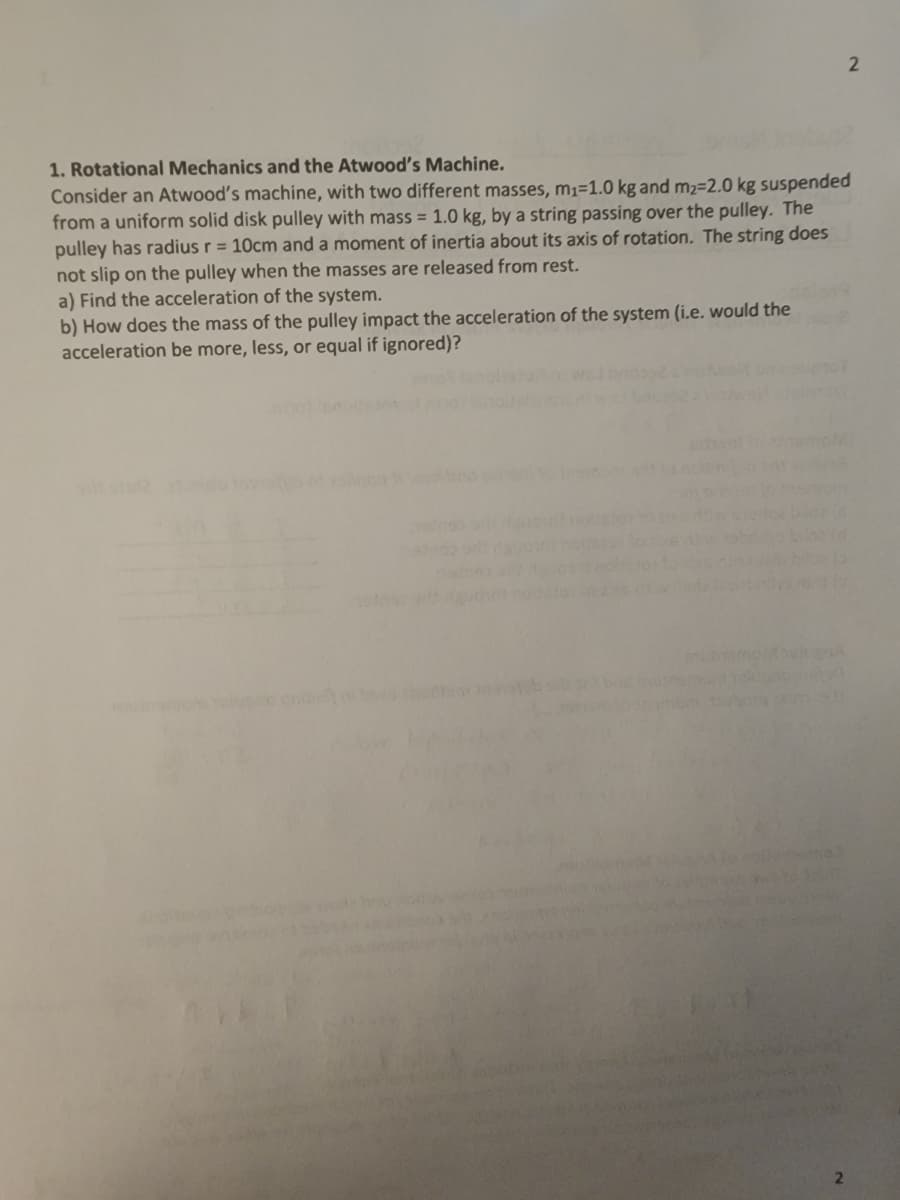1. Rotational Mechanics and the Atwood's Machine. Consider an Atwood's machine, with two different masses, m1=1.0 kg and m2=2.0 kg suspended from a uniform solid disk pulley with mass = 1.0 kg, by a string passing over the pulley. The pulley has radius r = 10cm and a moment of inertia about its axis of rotation. The string does not slip on the pulley when the masses are released from rest. a) Find the acceleration of the system. b) How does the mass of the pulley impact the acceleration of the system (i.e. would the acceleration be more, less, or equal if ignored)? %3D
1. Rotational Mechanics and the Atwood's Machine. Consider an Atwood's machine, with two different masses, m1=1.0 kg and m2=2.0 kg suspended from a uniform solid disk pulley with mass = 1.0 kg, by a string passing over the pulley. The pulley has radius r = 10cm and a moment of inertia about its axis of rotation. The string does not slip on the pulley when the masses are released from rest. a) Find the acceleration of the system. b) How does the mass of the pulley impact the acceleration of the system (i.e. would the acceleration be more, less, or equal if ignored)? %3D
Physics for Scientists and Engineers with Modern Physics
10th Edition
ISBN:9781337553292
Author:Raymond A. Serway, John W. Jewett
Publisher:Raymond A. Serway, John W. Jewett
Chapter10: Rotation Of A Rigid Object About A Fixed Axis
Section: Chapter Questions
Problem 15P: A grinding wheel is in the form of a uniform solid disk of radius 7.00 cm and mass 2.00 kg. It...
Related questions
Question
100%

Transcribed Image Text:1. Rotational Mechanics and the Atwood's Machine.
Consider an Atwood's machine, with two different masses, m1=1.0 kg and m2=2.0 kg suspended
from a uniform solid disk pulley with mass = 1.0 kg, by a string passing over the pulley. The
pulley has radius r = 10cm and a moment of inertia about its axis of rotation. The string does
not slip on the pulley when the masses are released from rest.
a) Find the acceleration of the system.
b) How does the mass of the pulley impact the acceleration of the system (i.e. would the
acceleration be more, less, or equal if ignored)?
2.
Expert Solution
This question has been solved!
Explore an expertly crafted, step-by-step solution for a thorough understanding of key concepts.
Step by step
Solved in 2 steps with 2 images

Knowledge Booster
Learn more about
Need a deep-dive on the concept behind this application? Look no further. Learn more about this topic, physics and related others by exploring similar questions and additional content below.Recommended textbooks for you

Physics for Scientists and Engineers with Modern …
Physics
ISBN:
9781337553292
Author:
Raymond A. Serway, John W. Jewett
Publisher:
Cengage Learning

Physics for Scientists and Engineers, Technology …
Physics
ISBN:
9781305116399
Author:
Raymond A. Serway, John W. Jewett
Publisher:
Cengage Learning

College Physics
Physics
ISBN:
9781285737027
Author:
Raymond A. Serway, Chris Vuille
Publisher:
Cengage Learning

Physics for Scientists and Engineers with Modern …
Physics
ISBN:
9781337553292
Author:
Raymond A. Serway, John W. Jewett
Publisher:
Cengage Learning

Physics for Scientists and Engineers, Technology …
Physics
ISBN:
9781305116399
Author:
Raymond A. Serway, John W. Jewett
Publisher:
Cengage Learning

College Physics
Physics
ISBN:
9781285737027
Author:
Raymond A. Serway, Chris Vuille
Publisher:
Cengage Learning

Physics for Scientists and Engineers: Foundations…
Physics
ISBN:
9781133939146
Author:
Katz, Debora M.
Publisher:
Cengage Learning

College Physics
Physics
ISBN:
9781305952300
Author:
Raymond A. Serway, Chris Vuille
Publisher:
Cengage Learning

College Physics
Physics
ISBN:
9781938168000
Author:
Paul Peter Urone, Roger Hinrichs
Publisher:
OpenStax College